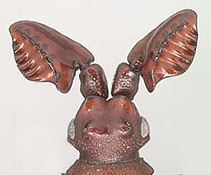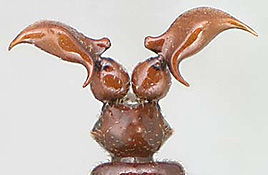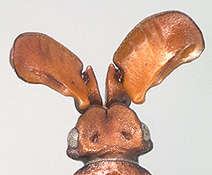
Guest blogging for Donovan is Dr. Wendy Moore of the California Academy of Sciences.
With roughly 350,000 described species, beetles are without a doubt one of the most successful forms of life on Earth. Many beetle species use chemicals to defend themselves, but the true masters of chemical defense are the Bombardier Beetles which deliver their defensive chemicals hot, really hot -- up to 212 degrees F (100 degrees C). Yes, that's right, there are beetles living right here in the San Francisco Bay Area that discharge chemicals at the boiling point of water! They have a two-chambered defensive gland and each chamber contains different chemicals. When mixed, the chemicals react with one another to produce so much heat that it literally explodes out of an opening on the abdomen, and kaboom! It's a built-in arsenal that deters nearly all predators.
 I study a subgroup of these beetles known as the Flanged Bombardier Beetles. This group is incredible not only because they bombard, but also because most species live inside ant nests. That is particularly strange, because ants are extremely aggressive with fine-tuned strategies for keeping non-family members out of their nest. Normally foreigners that try to enter an ant nest are destroyed immediately. Although ants do not have good eyesight, they perceive the world through their sense of touch and taste. Colony members wear an invisible veil of chemicals, which allows them to recognize each other. When a non-family member is in the vicinity of a nest, ants attack first and ask questions later. But ant defenses are not foolproof and many species of Flanged Bombardier Beetles have managed to crack their secret chemical code.
I study a subgroup of these beetles known as the Flanged Bombardier Beetles. This group is incredible not only because they bombard, but also because most species live inside ant nests. That is particularly strange, because ants are extremely aggressive with fine-tuned strategies for keeping non-family members out of their nest. Normally foreigners that try to enter an ant nest are destroyed immediately. Although ants do not have good eyesight, they perceive the world through their sense of touch and taste. Colony members wear an invisible veil of chemicals, which allows them to recognize each other. When a non-family member is in the vicinity of a nest, ants attack first and ask questions later. But ant defenses are not foolproof and many species of Flanged Bombardier Beetles have managed to crack their secret chemical code.
For these clever beetles, going incognito is like going on an all-expenses-paid vacation. Ant nests are stable, dark, moist environments -- luxurious accommodations by insect standards. And since they don't have to worry about the ants themselves, the nests are virtually predator-free, making them safe places for adult beetles to lay their eggs and for their offspring to develop.

